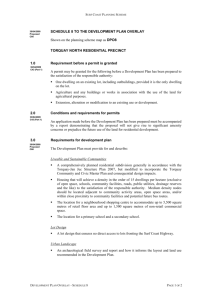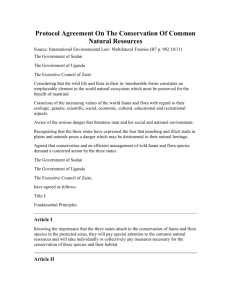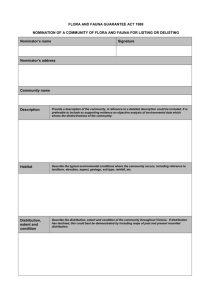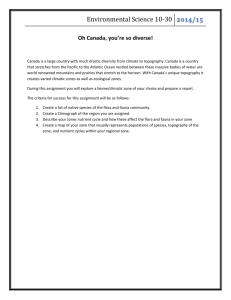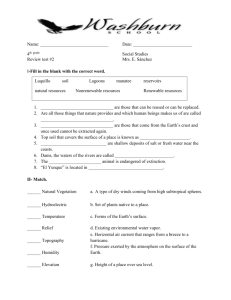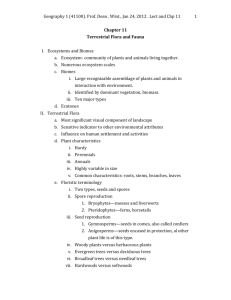terrestrial flora & fauna pt2
advertisement
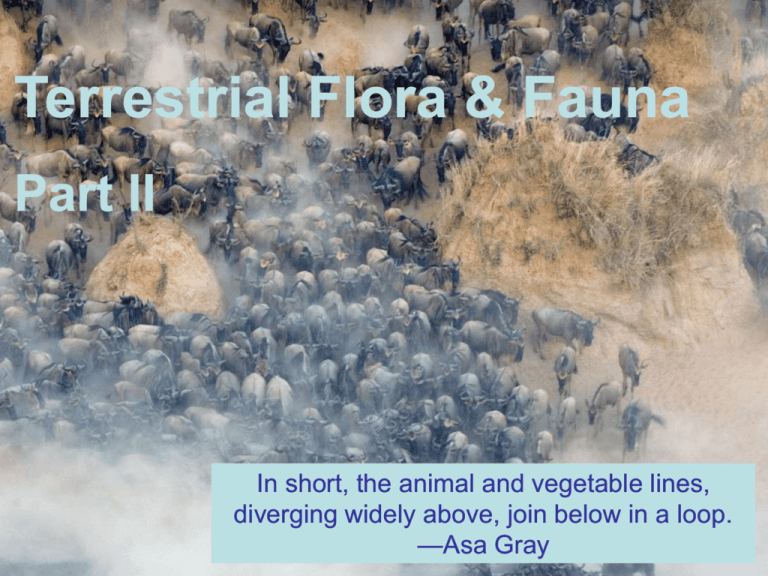
Terrestrial Flora & Fauna Part II In short, the animal and vegetable lines, diverging widely above, join below in a loop. 1 —Asa Gray Zoogeographic Regions • Reflective of the general distribution of energy and richness of food chemistry 2 • Ethiopian Region – Bounded by oceanic barriers on three sides and broad desert on the fourth. – Greatest number of mammalian families 3 • Oriental Region – Separated from rest of Eurasia by mountains – Large number of reptiles and venomous snakes 4 • Palearctic Region – Separated from rest of Eurasia by mountains – Few endemic species, fewer species than in tropics 5 • Nearctic Region – Non-tropical portions of North America – Similar to Palearctic due to Bering land bridge 6 – Bering Land Bridge 7 • Neotropical Region – Geographical isolation and variety of habitats – Rich assemblage, largest number of endemic mammal families 8 • Other Regions – All noted for their geographical isolation and resulting endemic species – Madagascar Region • Primitive primates (lemurs) – New Zealand Region • Large proportion of birds, some flightless • No mammals, few reptiles and amphibians – Pacific Islands Region • Limited fauna assemblage 9 • Australia Region – Australia and adjacent islands – Most distinctive fauna of any region due to the region’s lengthy isolation • Few placental mammals – Its unique biota are also primarily a result of isolation Kangaroo Monotremes (egg-laying mammals) Echidna and duckbill platypus. 10 Major Biomes • Summary of each biome follows… – Distribution (map) – Climate types – Main vegetation types – Limiting factors to flora and fauna 11 12 • Tropical Rainforest – Distribution – Climate types – Main vegetation types – Limiting factors to flora and fauna 13 • Tropical Deciduous Forest – Distribution – Climate types – Main vegetation types – Limiting factors to flora and fauna 14 • Tropical Scrub – Distribution – Climate types – Main vegetation types – Limiting factors to flora and fauna 15 • Tropical Savanna – Distribution – Climate types – Main vegetation types – Limiting factors to flora and fauna 16 • Desert – Distribution – Climate types – Main vegetation types – Limiting factors to flora and fauna 17 • Mediterranean Woodland and Shrub – Distribution – Climate types – Main vegetation types – Limiting factors to flora and fauna a. Moist winter b. Early summer, hot c. Summer fire season d. Fire aftermath 18 • Midlatitude Grassland – Distribution – Climate types – Main vegetation types – Limiting factors to flora and fauna 19 • Midlatitude Deciduous Forest – Distribution – Climate types – Main vegetation types – Limiting factors to flora and fauna 20 • Boreal Forest – Distribution – Climate types – Main vegetation types – Limiting factors to flora and fauna 21 Human Modification of Natural Distribution Patterns • Physical Removal of Organisms – Plowed, paved over, cut down, overgrazed, burned, poisoned, shot or trapped to extinction An overgrazed range (on left) in Colorado 22 • Habitat Modification – Rates • Vary within the five major rainforest regions • Highest removal rates in southern and southeastern Asia (teak and mahogany, especially) Central America – one of the highest rates of deforestation (due mainly to expansion of cattle ranching) 23 • Removal for agriculture often results in soil erosion and low crop yields as well as wildlife habitat destruction. 24 • Artificial Translocation of Organisms – Example: Feral burros from mining days in the US southwestern desert. 25 – Biotic Rearrangement: The Sad Case of Florida • Major world center for plant and animal import industry • Many exotic species have spread to the natural ecosystems of the state, upsetting their balance and causing extinction of native organisms. • Example: Walking catfish from Southeast Asia 26 Summary • The natural distribution of any biotic group due to the group’s evolutionary development, migration — dispersal history, reproductive success and trend toward extinction. • Most organisms have evolved adaptations to the four main limiting factors of an ecosystem: light, water, shelter and nutrients. • Competition is critical to an organism’s survival. 27 • Plants are categorized into four groups: bryophytes and pteridophytes, which are relatively simple spore-bearing plants, and gymnosperms and angiosperms, which are more complex seed-bearing plants. • The principle major floristic associations include forests, woodlands, shrub lands, grasslands, deserts, tundra, wetlands and mountains. 28 • Terrestrial fauna has developed physiological, behavioral, reproductive adaptations to cope with the limiting factors of landscapes. • For general geographical studies, useful faunal groups are invertebrates, fishes, amphibians, reptiles, birds and mammals. • Competition among animals involves rivalry for territory and resources. • Among some animals, there are mutually beneficial relationships called symbiotic relationships. 29 • Worldwide, nine zoogeographical regions and ten major biomes are generally recognized. • Natural distributions of biota are often severely altered by human activities through physical removal, habitat modification and artificial translocation. 30
